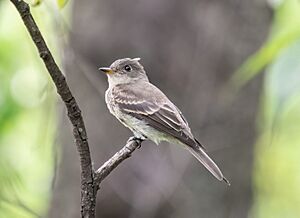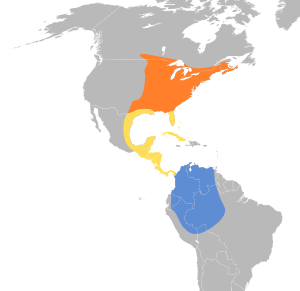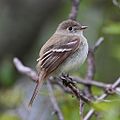Eastern wood pewee facts for kids
Quick facts for kids Eastern wood pewee |
|
|---|---|
 |
|
| In Central Park, New York, USA | |
| Conservation status | |
| Scientific classification | |
| Genus: |
Contopus
|
| Species: |
virens
|
 |
|
| Approximate distribution map
Breeding Migration Non-breeding |
|
| Synonyms | |
|
Muscicapa virens Linnaeus, 1766 |
|
The eastern wood pewee (Contopus virens) is a small bird that lives in North America. It's a type of tyrant flycatcher. This bird looks almost exactly like its cousin, the western wood pewee. For a long time, people thought they were the same species! The easiest way to tell them apart is by listening to their unique calls.
Contents
About Its Name
The eastern wood pewee got its scientific name from Carl Linnaeus in 1766. He was a famous Swedish scientist. He called it Muscicapa virens. The word virens is Latin and means "green."
Later, in 1855, a German bird expert named Jean Cabanis placed this bird in a new group, or genus, called Contopus. This bird is the only one of its kind in this specific group.
What It Looks Like

The eastern wood pewee is a small bird, about 13.5 to 15 centimeters (5 to 6 inches) long. It weighs around 14 grams (half an ounce). Its wings can spread about 23 to 26 centimeters (9 to 10 inches) wide. Both male and female birds look the same.
Their upper body is gray-olive, and their belly is lighter. Their chest has a bit of an olive color. Each wing has two light-colored stripes. Their main wing feathers are long, making their wingtips look thin and pointy. The top part of their beak is dark, and the bottom part is yellowish.
This bird is named after its song! It makes a sad, whistling sound that goes pee-a'wee. It also sings a "pe-wee" sound that ends with a rising note.
Similar Birds
It can be tricky to tell the eastern wood pewee apart from other birds. Here are some similar ones:
- The western wood pewee (C. sordidulus) looks almost identical. But it lives in a different area, more to the west. Its song is also very different, sounding like a descending tsee-tsee-tsee-peeer.
- The eastern phoebe (Sayornis phoebe) also looks similar, especially after it has lost some feathers. However, it doesn't have clear wing stripes. It also bobs its tail often. Phoebes arrive earlier in the spring than wood pewees. Their songs (fee-bee, fee-bee) and calls (chip) are quite different.
- The least flycatcher (Empidonax minimus) looks a lot like the eastern wood pewee. But it has a clear ring around its eye. It also has shorter wings and a shorter beak. It is smaller overall. Its songs (che-bec, che-bec) and calls (a sharp whit) are very different.
-
The western wood pewee looks very much like its close relative.
-
The eastern phoebe does not have bold wing stripes and has shorter wing feathers.
-
The least flycatcher has clear eye-rings and shorter wing feathers.
Where It Lives
Eastern wood pewees live in deciduous forests, mixed woods, or pine tree farms. These are their breeding grounds in eastern North America. When winter comes, they fly south. They migrate to Central America, the Caribbean, and the Andes mountains in northern South America.
These birds eat insects and other small creatures like spiders. They like to sit on a tree branch at a middle height. From there, they fly out to catch insects in the air. Sometimes, they hover to pick bugs off plants.
Eastern wood pewees arrive late in their breeding areas, usually in late May or early June. They leave for the south in late August or September. They travel quickly for most of their journey.
How It Behaves
Raising Young
The eastern wood pewee builds a cup-shaped nest. It uses grasses, tree bark, and lichen. It attaches the nest to a horizontal tree branch using spider webs. Nests can be anywhere from 4.5 to 18 meters (15 to 60 feet) high. Most nests are about 9 meters (30 feet) up. They often build nests in oaks, pines, birches, and maples.
The female usually lays three (sometimes two) eggs. The eggs are white and slightly see-through. They have brown spots, mostly at the wider end. The male bird protects the nesting area. He will fight with other wood pewees and even chase away other bird species. Sometimes, a male bird might mate with two females at the same time.
The eggs hatch in about 12 to 14 days. Both parents bring food to the baby birds, called nestlings. The nestlings are born helpless and need a lot of care. They usually leave the nest 15 to 17 days after hatching. They often land on the ground during their first flight. The adult birds will sit on a nearby branch and call to the young. They stay in touch and feed them until the young birds can fly well enough to join them.
Conservation Status
The eastern wood pewee is a common bird and can be found in many places. Because of this, it is not considered globally endangered by the IUCN. However, its numbers have been going down in recent years. This might be because they are losing their forest homes where they spend the winter.
Another reason could be the increase in white-tailed deer in their breeding areas. More deer can change the plants and insects in the lower parts of the forests. This might affect the food available for the eastern wood pewee.
See also
 In Spanish: Pibí oriental para niños
In Spanish: Pibí oriental para niños






